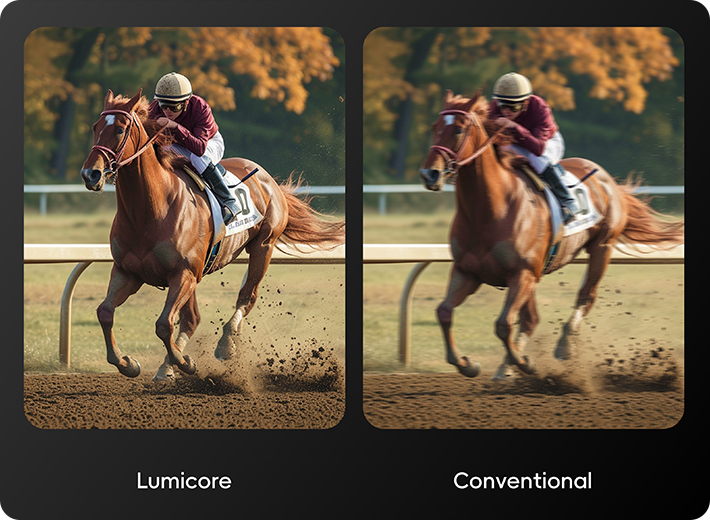
Lumicore's independently designed and produced micro-display is based on micro-OLED technology and features 100% proprietary FSL technology.
It integrates various advanced technologies, resulting in groundbreaking achievements in micro-OLED technology. This innovative solution offers high performance, low power consumption, and cost-effectiveness for mass production.



Micro-OLED is a type of OLED microdisplay, which differs from traditional TFT-OLED displays in that it uses a single-crystal silicon substrate. The single-crystal silicon integrates CMOS driving circuits, allowing for a reduction in pixel size to approximately 1/10 of the original size, thereby achieving higher display precision.
It is expected to become the primary display window in future virtual reality interactions.




Maximum refresh rate 144Hz
Lumicore utilizes FSL technology's digital driving technique to achieve a maximum refresh rate of 144Hz, providing a seamless natural experience for near-eye displays, akin to how the human eye observes motion in the physical world.
It adapts to the current VR content ecosystem dominated by videos and games.


Good low gray display effect
In high grayscale levels, micro-displays present rich colors, intricate details, and a refined image quality. However, in low grayscale levels, maintaining the same level of color performance becomes challenging, especially below 16 grayscale levels where details are severely compromised.
Digital scanning utilizes pulse width modulation to adjust brightness, achieving exceptional low-gray performance. Even below 16 grayscale levels, the micro-display maintains impressive detail representation.
Wide color gamut has been widely recognized by display manufacturers and users, but ensuring consistent and outstanding display performance in different scenarios is also an essential characteristic of a high-level product.


ANSI contrast ratio 900:1
Micro-OLED is a miniaturized OLED technology where each pixel can be individually lit or turned off, eliminating the need for a backlight like LCD displays. This enables true black and infinite contrast.
Lumicore utilizes digital driving and achieves excellent contrast performance on microdisplays, with an ANSI test showing a contrast ratio of 600:1.


Born with good effects of Motion blur
Motion blur can cause dizziness and affect the duration of VR device usage. One common solution is the use of black frame insertion technology. However, this can increase the demand for the maximum brightness of the display and may cause screen flickering, potentially harming the eyes.
FSL technology's digital driving inherently optimizes motion blur. By dividing a frame into multiple sub-frames, each with a display time much lower than the human eye's perception limit, the motion blur generated by the sub-frames can be disregarded. Additionally, the majority of low-brightness sub-frames are not impacted by motion blur.



Eye Protection
In virtual reality environments, severe screen flickering can potentially cause damage to the eyes. Additionally, repeated flickering of the same screen can lead to motion blur issues.
Lumicore's FSL technology utilizes digital scanning subfields with a high refresh rate of up to 3KHz, enabling a higher flicker frequency in the same scene and meeting the requirements for eye protection.


Lumicore micro-OLED utilizes digital driving to achieve low power consumption advantages. The digital driving technique employs a display backplane without capacitors, simplifying the pixel circuit structure and minimizing power consumption.
Lumicore micro-OLED reduces circuit power consumption by 30-50% and improves OLED device lifespan by 20-30%.

Lumicore employs digital driving to achieve higher grayscale and resolution at a lower cost process node. Digital driving relies on a simple and stable structure, improving the yield rate of the substrate chip while reducing costs and expanding production capacity.






